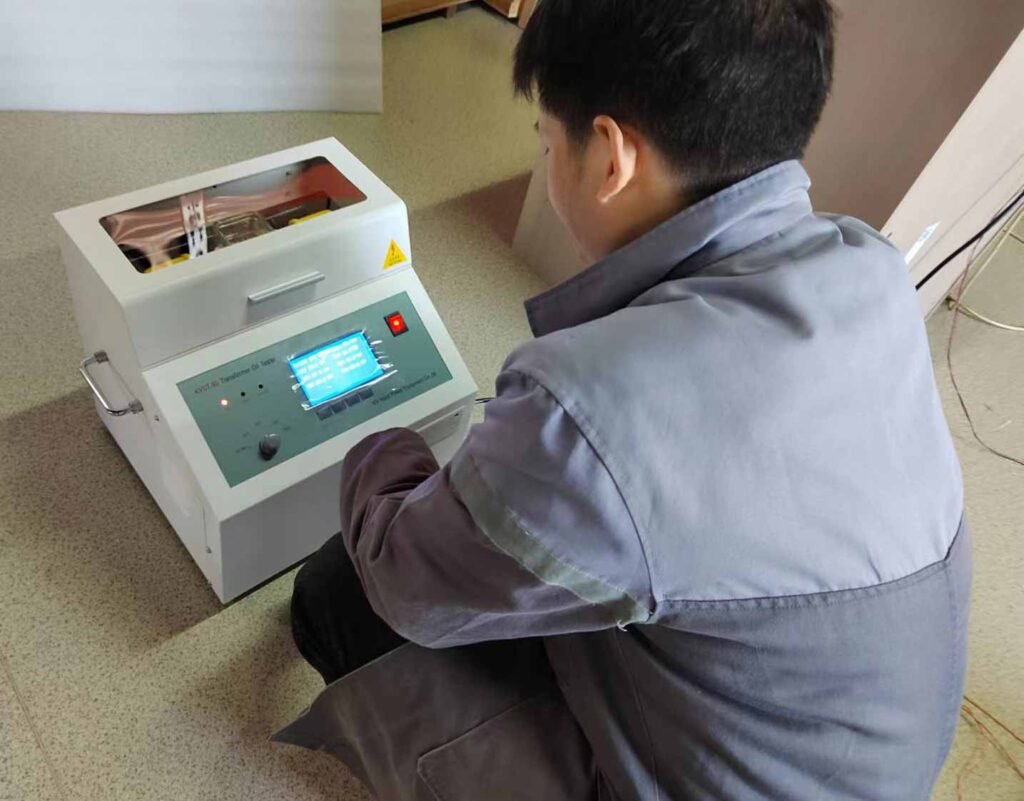Insulation Oil (Transformer Oil ) is a insulation material ,which is mainly improve the insulation of electrical equipment to avoid the failure of equipment breakdown and electric leakage . Insulating oil is widely used in high-voltage electrical equipment such as transformers, oil circuit breakers, oil-filled cables, power capacitors and bushings.
Insulation Oil is mail function is insulation , cooling and arc extinguishing as followings:
- Insulation: Insulating oil impregnates and protects solid insulation components like transformers, cables, and capacitors. It fills air bubbles, prevents intrusion of air or moisture, and ensures reliable insulation.
- Cooling Effect: Insulating oil has good cooling properties, allowing it to effectively dissipate heat in electrical equipment like transformers.
- Arc Extinguishing: In oil circuit breakers, the insulating oil not only provides insulation but also helps extinguish the electric arc, enabling quick and reliable circuit breaking.
Due to oxygen, high temperature, high humidity,electric arc , strong electric field and impurities, the performance of insulation oil will gradually deteriorate during operation . It can not fully play the role of insulation, so it must be regularly carried out the insulation oil testing to identify whether its performance deteriorates.

Why is it important to test transformer oil?
Analyzing the insulation oil in transformers is extremely important. It helps in detecting early signs of problems, ensuring efficient cooling and insulation, and ultimately extending the service life of the transformer while complying with industry standards and regulations
Condition Monitoring
Routine oil testing allows for early detection of potential problems, such as oil degradation, moisture ingress, or internal faults.
By monitoring changes in key oil parameters over time, you can identify trends and take preemptive maintenance actions before major issues arise.
Dielectric Strength Evaluation
The dielectric strength of the oil is a crucial indicator of its ability to withstand electrical stress without breakdown.
Reduced dielectric strength can lead to insulation failure and catastrophic transformer damage.
Identification of Contaminants
Testing can detect the presence of contaminants like water, particles, or dissolved gases in the oil.
These contaminants can compromise the oil’s insulating properties and accelerate the deterioration of the transformer.
Detection of Aging/Degradation:
Parameters like acid number, interfacial tension, and dissipation factor provide insights into the aging and oxidation of the oil.
Monitoring these factors helps determine the remaining useful life of the oil and the overall transformer condition.
Risk Mitigation:
Proactive oil analysis and maintenance helps prevent unplanned transformer failures, which can be extremely costly in terms of equipment damage, downtime, and potential safety hazards.
Regulatory Compliance
Many utilities and industries have standards and regulations that mandate regular transformer oil testing and record-keeping.
Adhering to these requirements ensures the safety and reliability of the electrical infrastructure.
What are the tests for transformer oil?

There are some tests for insulation oil testing include Breakdown voltage (BDV)test, water content test, acidity test, Dielectric Dissipation Factor test, Interfacial Tension test, Flash Point test, Viscosity test, Relative Density Test, Furan Analysis , Dissolved Gas Analysis (DGA)ect.
Here we list out the test method and standard for insulation oil .
Transformer Oil Test Item and Standard
| Test Item | Standard |
|---|---|
| Dielectric Strength (BDV test) | ASTM D877, ASTM D1816, IEC 60156 |
| Water Content | ASTM D1533, IEC 60814 |
| Acidity (Acid Number) | ASTM D974, IEC 62021-1 |
| Dielectric Dissipation Factor (DDF)/Tan Delta | IEC 60247 / ASTM D924 |
| Interfacial Tension (IFT) | ASTM D971 |
| Flash Point | ASTM D92 / ISO 2592 |
| Kinematic Viscosity | ASTM D445 / ISO 3104 |
| Relative Density | ASTM D1298 / ISO 3675 |
| Dissolved Gas Analysis (DGA) | IEC 60567 / ASTM D3612 |
Here we talk about the transformer oil test type
Breakdown voltage test(BVD test)
Transformer oil breakdown voltage is to test the transformer oil to withstand the limit of electrical stress, is a very important means of supervision, usually, it mainly depends on the degree of contamination, but when the oil in the water is high or contains impurity particles, the breakdown voltage has a greater impact .
Insulation Oil Dielectric Tester is used to carry on power frequency dielectric break down test on the transformer oil, capacitor oil

Water Content Test
Moisture is one of the most important causes of insulation aging in transformer equipment. Transformer oil and insulating materials in the water content increases, directly leading to a decline in insulation performance and will promote the aging of the oil, affecting the reliability of the operation of the equipment and service life.
Interfacial Tension Test
The determination of interfacial tension between oil and water is an indirect and effective method of checking that the oil contains soluble polar impurities resulting from aging. In the initial aging stage of oil, the change of interfacial tension is quite rapid, and in the middle of aging, the rate of change decreases. The sludge generation increases significantly, therefore, this method can also make a reliable judgment on the trend of sludge generation.
Automatic Tension Tester is used to test various liquid surface tension and interface tension based on the ring method
Dielectric Dissipation Factor Test
Dielectric loss factor to determine the degree of transformer oil aging and pollution is very sensitive. New oil contains few polar impurities, so the dielectric loss factor is also very small, generally only 0.01% to 0.1% order of magnitude; but due to oxidation or overheating caused by oil aging, or mixed with other impurities, the generation of polar impurities and charged colloidal material gradually increased, the dielectric loss factor will also increase, in the oil aging products are very small, chemical methods can not be detected when the dielectric loss factor can be clearly distinguished
Acidity (Acid Number)Test
Transformer oil is generally easy to generate low molecular organic acids in the primary stage of oxidation , such as formic acid, acetic acid, etc.. Because the water solubility of these acids is better, when the oil in the water-soluble acid content increases ( pH value is lowered), and the oil contains water, it will make the solid insulating materials and metal corrosion, and reduce the insulating properties of electrical equipment, shortening the service life of the equipment.

Flash Point Test
Flash point is an essential item for the supervision of operating oils. A decrease in flash point indicates that volatile combustible gases are generated in the oil; these combustible gases are often generated by localized overheating of electrical equipment and thermal cracking of insulating oil at high temperatures caused by arc discharge. Through the determination of the flash point can be timely detection of equipment failure. At the same time for the new filling equipment and maintenance treatment of transformer oil, the determination of the flash point can also prevent or find out whether the oil mixed with light distillates, so as to protect the safe operation of the equipment!
Kinematic Viscosity Test
One of the main functions of insulating oils is to dissipate heat by conduction, either by itself or by forced circulation (natural and forced). This function is essential to maintain proper operation of electrical equipment. If the viscosity of the insulating oil is too high, it may interfere with the effective flow and heat transfer of the equipment, resulting in overheating or reduced operating efficiency.
Therefore, in order to ensure that the insulating oil can effectively conduct heat transfer and dissipate heat, its viscosity needs to be controlled within a certain range to ensure that the oil has good fluidity, thus effectively reducing the equipment’s operating temperature, ensuring the safe and stable operation of the equipment.
Specifically, the kinematic viscosity of the transformer oil is generally required to be no greater than 11mm2/s at 40°C. This requirement is to ensure that the insulating oil can still maintain good fluidity at higher temperatures, so as to effectively conduct and dissipate heat.
Relative Density Test
Relative density (also known as specific gravity) is the ratio of the density of the oil to the density of water at a specified temperature. For transformer oil, this property is typically measured at 15°C.
Oil relative density test is a crucial parameter in assessing the quality and performance of transformer oil.
Dissolved Gas Analysis(DGA) Test
For transformer oils in normal operation, small amounts of CO2, CO and traces of low molecular hydrocarbons are produced as a result of slow decomposition and oxidation of the oil and insulating materials, but in much smaller quantities compared to the amount of gases produced by faults. In other words, for normal operation of the transformer, the background value of the relevant components in the oil is low, which provides favorable conditions for identifying the significant growth of characteristic gases under faults.
When faults occur within the transformer, mainly due to thermal (current effect) and electrical (voltage effect) faults in the insulating oil and solid insulating material, the gases of CO2, CO, H2 and low molecular hydrocarbons in the oil increase significantly.
Combustible gases in the oil are generally due to localized overheating or discharge decomposition of the equipment. If the cause of combustible gases is not identified and eliminated in time, the safe operation of the equipment is very dangerous.

By analyzing the types and concentrations of these gases, you can diagnose potential issues and problems in the transformer.
Key Gases Analyzed in DGA :
Hydrogen (H2)
Methane (CH4)
Ethylene (C2H4)
Ethane (C2H6)
Acetylene (C2H2)
Carbon monoxide (CO)
Carbon dioxide (CO2)
Transformer Oil Dissolved Gas Analyzer (Transformer Oil Gas Chromatography Analyzer) uses chromatographic method to determine the content of dissolved gas in transformer oil.
Transformer Oil Dissolved Gas Analyzer uses chromatographic method to determine the content of dissolved gas in transformer oil. It is effective for power generation and power supply companies to determine whether there are latent overheating, discharge and other faults in oil-filled power equipment in operation to ensure safe and effective operation of the power grid. means.
It is also a necessary means for manufacturers of oil-filled electrical equipment to carry out factory inspections of their equipment. It is suitable for the determination of the content of the dissolved gas components in the insulating oil of the power system.
The full analysis of the content of the 7 gas components dissolved in the insulating oil can be completed with one sample injection. Composition of detection objects: Hydrogen (H2), Methane (CH4), Ethylene (C2H4), Ethane (C2H6), Acetylene (C2H2), Carbon monoxide (CO), Carbon dioxide (CO2).
FAQ
What are the key properties of a good transformer insulation oil?
Key properties include high dielectric strength, low viscosity, high oxidation stability, low acidity, and ability to inhibit sludge formation.
The oil should also have good heat transfer characteristics and compatibility with the transformer’s solid insulation materials.
How often should transformer oil be tested?
Routine oil testing is recommended at least annually, or more frequently depending on the transformer’s age, operating conditions, and criticality.
Common tests include dissolved gas analysis (DGA), dielectric strength, acidity, and moisture content.
What are the common causes of transformer oil degradation?
Thermal and electrical stress, exposure to oxygen, moisture ingress, and contamination can all contribute to oil degradation over time.
Signs of degradation include increased acidity, formation of sludge, and changes in the dissolved gas composition.
How can the life of transformer oil be extended?
Regular oil filtration and dehydration to remove contaminants and moisture.
Addition of oil inhibitors to improve oxidation stability.
Maintaining proper operating temperatures within the transformer.
Avoiding excessive electrical and thermal stresses on the oil.
What are the safety considerations when handling transformer oil?
Transformer oil is a flammable liquid, so proper safety protocols must be followed during handling, storage, and disposal.
Personal protective equipment (PPE) such as gloves and eye protection should be used when servicing oil-filled equipment.
Spill containment and proper disposal of used oil are also important safety measures.
Can transformer oil be recycled or re-refined?
Yes, spent transformer oil can often be recycled or re-refined to recover its useful properties and extend its service life.
Re-refining involves removing contaminants and restoring the oil’s dielectric and thermal characteristics.





